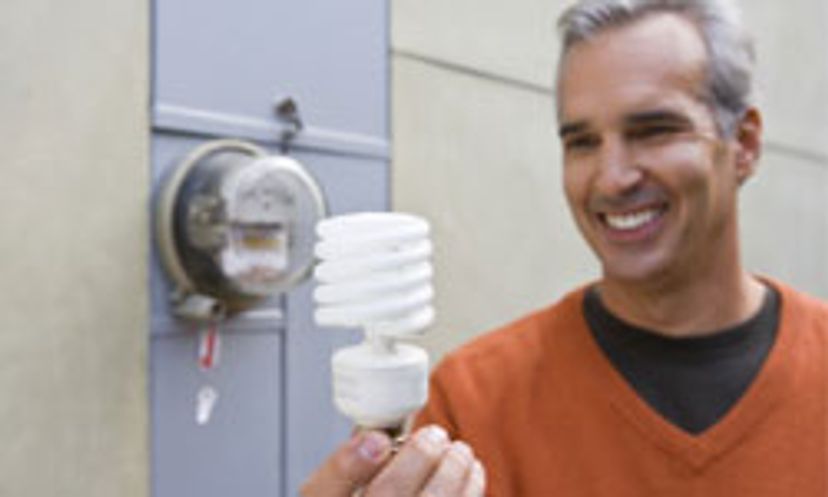Fact or Fiction: Energy Efficiency
Estimated Completion Time 3 min
"
Image: Brand X Pictures/Thinkstock
About This Quiz
Becoming more energy-efficient means using technology to help you consume less energy. So, how much do you know about making your home more energy efficient?
START QUIZ
American homes consume twice the energy of the world average.
almost fact: Try six times the world average.
Americans use six times more energy than everyone else.
Home duct efficiency in the United States could be as low as 50 to 70 percent.
almost fact: Duct efficiency could definitely be improved, but it's not that bad.
It is that bad. Researchers at Residential Energy Efficient Distribution Systems estimated about 50 to 70 percent efficiency nationwide.
Most American homes use natural gas for heat.
almost fact: Most American homes use electricity.
True -- 56 percent of American homes use natural gas.
In the past 25 years, American energy consumption has risen faster than the population has.
almost fact: The increase has been about the same for both.
Actually, thanks to advances in energy efficiency, the population has risen 24 percent and energy consumption has increased only 13 percent.
A 2009 study showed that replacing old appliances is one of the most important things people can do to reduce greenhouse-gas emissions.
almost fact: The best thing to do is unplug your old appliances when they're not in use.
Yes, according to the 2009 study by McKinsey & Company, switching to newer, more energy-efficient appliances is the key to reducing emissions.
Buildings with light-colored roofs use 40 percent less energy for cooling than buildings with darker roofs.
almost fact: A "green roof" is really the only kind that saves energy.
Your roof's color does matter -- light-colored ones are much more energy-efficient.
Traditional incandescent light bulbs convert about half the electricity they use into light -- the other half is converted into heat.
almost fact: Incandescent light bulbs convert almost all electricity into light.
Incandescent bulbs are terribly energy-inefficient -- only 10 percent of the electricty they use is converted into light.
Replacing a front-loading washing machine with a top-loader could save you $100 a year in energy, water and detergent.
almost fact: Front-loading machines are more energy efficient.
Front-loading is the way to go.
The newest energy-efficient refrigerators use 40 percent less energy than conventional models did in 2001.
almost fact: They use 20 percent less energy.
Yes, it's a fact -- today's refrigerators sporting Energy Star labels use 40 percent less energy than 2001 conventional models.
If you're on the market for new home insulation, it's best to get one that has a high E-rating.
almost fact: Actually, you need to look for lower E-ratings.
You do want to look for a high number, but it's an R-rating that you want, not E.
A programmable thermostat will save you about $90 a year.
almost fact: A new Energy Star refrigerator will save you about $90, a thermostat about half of that.
Even better -- you'll save about $180 by installing a programmable thermostat.
If you have a programmable thermostat (which you should), your home's night temperature should be 10 degrees lower than the day temperature.
almost fact: You should set a lower night temperature only if you live in a very warm climate.
You should have a lower temperature at night, but the Environmental Protection Agency says you need to go only 4 degrees lower.
You'll save 4 to 8 percent on cooling costs for every degree that you lower your thermostat in the summer.
almost fact: That would be raise, not lower.
Raising your home's temperature in the summer and lowering it in the winter will save you money.
You should change your HVAC filter every six months.
almost fact: Once a year is fine.
Nope, according to EnergyStar.gov, you need to change your filter every three months.
Properly sealing your home can cut your heating and cooling bills in half.
almost fact: Sealing your house is something you should definitely do, but it will save you about 10 percent.
Ten percent annually is still a pretty hefty savings, and most homes aren't properly sealed.
You can get a tax credit for energy-efficient improvements to a new home.
almost fact: The tax credit is only for improvements to existing homes, not for new homes.
For 2009 and 2010, you can get tax credits for energy-efficient improvements to an existing home -- 30 percent of the cost, up to $1,500 total, for new windows, doors, insulation, roofs, HVAC systems and water heaters.
There are even better tax credits available for geothermal heat pumps, solar panels and solar water heaters.
almost fact: It’s the same deal as windows, doors, etc.
Yes, there are tax credits for those items at 30 percent of the cost, with no upper limit, through 2016.
You could see a 140 percent return on your money over 25 years if you install a solar power system.
almost fact: You might be able to get a 100 percent return, but that's stretching it.
It isn't cheap to install a solar power system, but a 140 percent return over 25 years is well within the expected range.
According to EnergyStar.gov, 30 percent of energy in commercial and industrial buildings is used inefficiently or unnecessarily.
almost fact: Try 70 percent.
It is 30 percent, which is still pretty shocking, no?
A 13-watt fluorescent light bulb emits the same amount of visible light as a 60-watt incandescent bulb.
almost fact: A 30-watt fluorescent bulb gives off the same light as a 60-watt incandescent bulb.
Yep, 13-watt fluorescent equals a 60-watt incandescent.
You Got:
/20
Share on Facebook
Share on Facebook
Brand X Pictures/Thinkstock
